As humans, we rely primarily on our vision to get around in our daily lives. Even though we have other senses like hearing, smell, and touch, we don’t depend on them as much as our eyesight. So, our senses of hearing and smell aren’t very sharp. Therefore, loud noises and strong smells don’t affect us that much. But for hamsters, it’s the other way round. They have very poor eyesight. So, they have to rely on their other senses to survive. As a result, their other senses have evolved to be pretty good. Their sense of hearing, in particular, is very sharp. So, hamsters are sensitive to sound.
As hamster owners, it is our duty to know which sounds can affect our pet hamsters so that we can create a safe and healthy environment for them. But to do that, we have to first find out what sounds our hamsters can hear.
Which sounds can a hamster hear?
Hamsters have an excellent sense of hearing when compared to humans.
We (humans) can only hear sounds with frequencies ranging from 20Hz to 20kHz. We cannot hear sounds in the ultrasonic range (>20kHz).
But the hearing range alone doesn’t paint a complete picture of an organism’s hearing ability. What also matters is how loud the noise should be at a particular frequency for the organism to be able to hear it.
The loudness of the noise can be measured by the sound pressure level and has the unit of dB (Decibel). Decibel is calculated on a logarithmic scale,i.e., a change of 1 dB indicates a change in loudness by 7% (Source: Logison Acoustic Network). So, the loudness of the noise doubles with every 10dB increase in the sound pressure level. For example, 60dB is twice as loud as 50dB and 32 times as loud as 10dB.
With this knowledge, look at the graph below to understand which frequencies we can hear well and which we cannot.
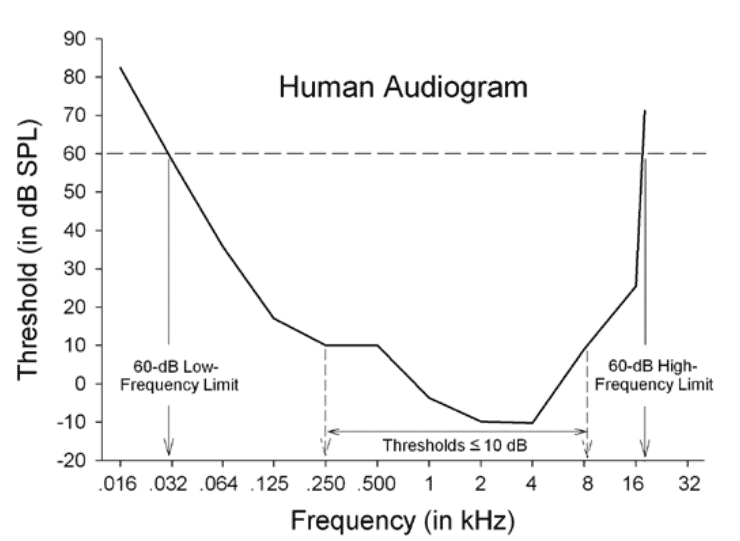
Compared to humans, hamsters can hear a broader range of sounds, ranging from 96Hz to 46.5kHz. So, they can hear sounds that are not even audible to us.
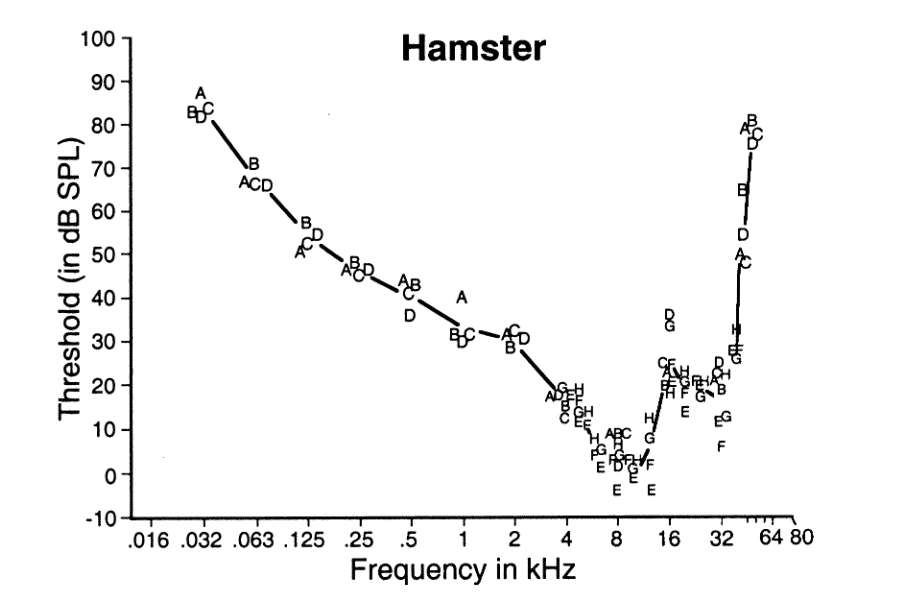
Now, we know that hamsters can hear a broader range of sounds than humans can. But can they hear as good as humans? Let’s find out.
Is a hamster’s hearing ability as good as a human’s?
To find the answer to this question, look at the picture below. The image compares the hearing ranges and abilities of humans, hamsters, and other animals. The thin lines represent the range of frequencies that an animal can hear only when it is loud enough (>60dB). The thick lines represent the range of frequencies that the same animal can hear, even if it is faint/soft (>10dB).
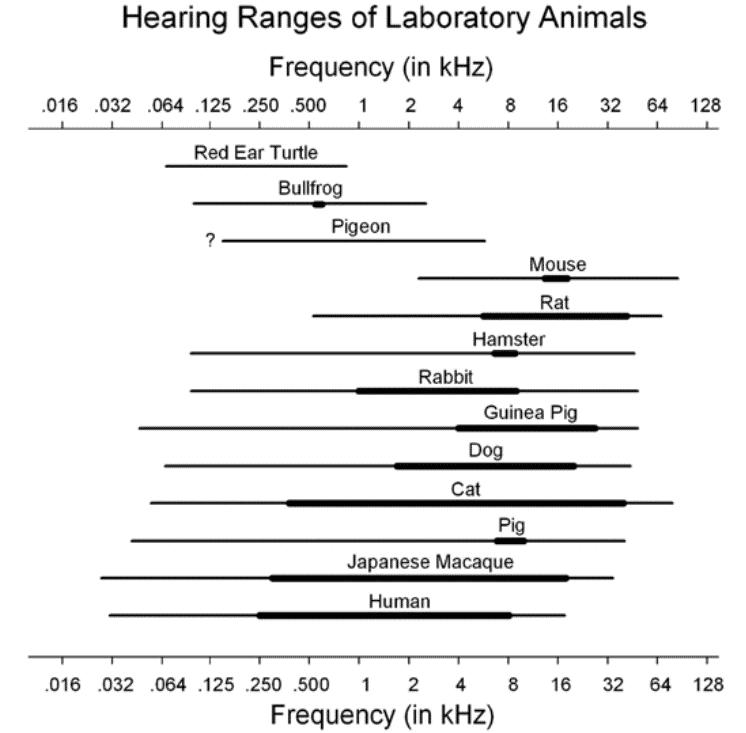
From this graph, you may have noticed that we can hear low-frequency sounds very well. On the other hand, our hamsters can hear low-frequency sounds only if they are loud. But they can hear high-frequency sounds (>6kHz) very well.
At first sight, this might seem like a huge disadvantage for hamsters. But it is actually an advantage for hamsters because it helps them eliminate the low-frequency sounds created by the ambiance in the environment and their own movement and focus only on the high-frequency sounds created by a predator. It helps wild hamsters survive.
How do different sounds affect hamsters?
Now that we know which sounds our hamsters are most sensitive to, let’s find out how these sounds are produced. You can find the frequencies and loudness of some familiar sounds in the human hearing range (in the picture below).
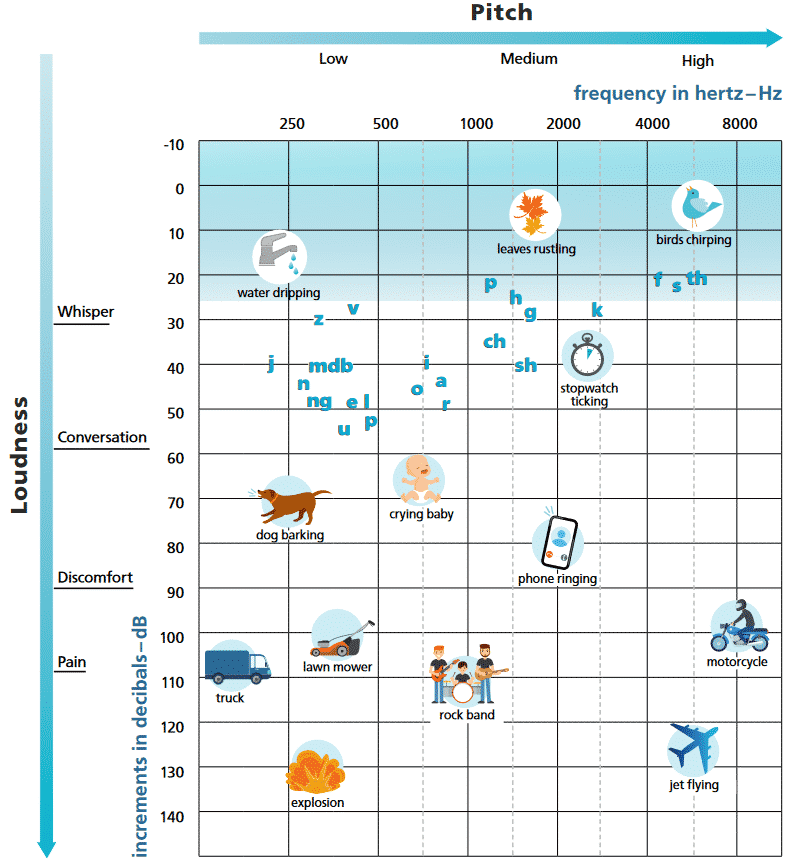
But besides the above sounds, the devices we use daily also produce sounds. Some of these devices might be too loud and can harm our hamsters. So, to be a responsible hamster parent, you should know which devices are safe to use when your hamster is around and which aren’t. The picture below can help you in this regard. It lists the loudness levels of some common household devices.
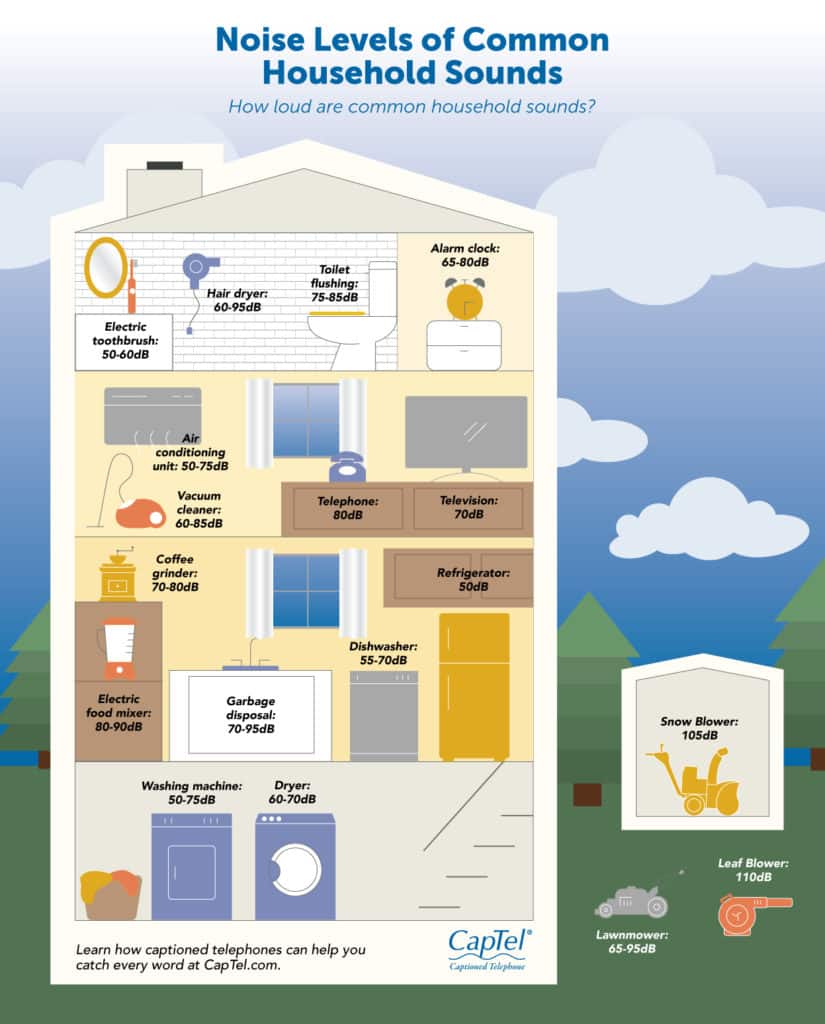
If a device is loud only in the low-frequency range, it won’t pose a great risk to our hamsters. Because it will be too loud for us, too. So, we would realize it and switch it off sooner, or at least don’t bring it near our hamsters. But some household devices can also produce sound in the high-frequency range (8kHz to 20kHz) and ultrasonic range (>20kHz). A few of these devices are:
- Vacuum cleaner (Source: US National Library of Medicine)
- Hairdryer (Source: Acoustical Society of America)
- Air conditioners (Source: NBC News)
- Blenders (Source: Heilscher)
- Lawn movers (Source: US National Library of Medicine)
- Leaf blowers (Source: Acoustic Society of Finland)
- Dog whistle (Source: Acoustical Society of America)
- Sensors of automatically opening doors
But sounds in the ultrasonic range are not audible to humans. Moreover, since we cannot hear sounds in the high-frequency range that well, even a loud noise in the high-frequency range might not sound that loud to us. So, we might miss these sounds. But for our hamsters, loud sounds in the high frequency and ultrasonic ranges might sound extremely loud.
But how can a noise, which doesn’t sound loud to us, sound too loud for our hamsters? Let’s find out.
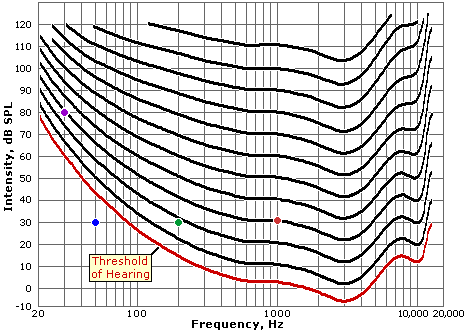
This curve is called the Equal loudness curve because it shows how loud a sound is at different frequencies (for a human being). An average person can hear all sounds above the red line.
If you follow the line containing the violet dot, you will find that a sound, which is 80dB loud (that’s pretty loud) at 30 Hz, is 30DB loud at 1,000Hz (the red dot) and just 20dB loud at 3,000Hz, where our hearing is at its best. If you follow the same curve, you will notice that a sound that is 60dB loud at 12,000Hz will only sound 20dB loud to us. But for our hamsters, they will still be 60dB loud (16 times louder than it sounds for us) because they can hear sounds at 12,000Hz very well (Look at the audiogram of a hamster in a previous section of this blog post).
After 20,000Hz, we don’t hear anything at all. But our hamsters can hear these sounds too.
Remember that, in the wild, such high-frequency sounds indicate to hamsters the arrival of a predator. For example, bats can use ultrasonic sounds to locate their prey. So, high frequency and ultrasonic sounds produced artificially by man-made devices can scare and stress out pet hamsters because they may think that a predator is nearby.
Can a sudden noise scare your hamster?
Definitely. Even though we can hear pretty well, our lives don’t depend on it. So, we have learned to subconsciously ignore many of these sounds. Therefore, the sound of a fridge door opening, a floorboard cracking, or a loud motorbike passing by might not scare us at all.
But a hamster’s life depends on its hearing. So, he looks for every small sound that might alert him to the arrival of predators. Moreover, his round ears make him more sensitive to sounds coming from above, as birds pose the most threat to him. (In comparison, a rabbit has tall ears which are sensitive to sounds coming from a horizontal direction because a rabbit is more likely to be hunted by a terrestrial predator (Source: Libretexts).
So, if you make a sudden sound, your hamster might stop doing whatever he was doing and freeze in time (stand still) with his ears held upright. But it is not something you need to worry about. It just means that your hamster heard or smelled something fishy. So, he is standing still, listening and smelling with all his might, trying to figure out if a predator is nearby.
Even though it is a natural reaction of a hamster to a sudden sound, it might still stress him out. Some hamsters might get used to sudden sounds like the sound of a fridge door opening, a floorboard cracking, etc., with time. Hence, they will get more tolerant of such background noises as they grow older. But some hamsters might never get used to these sounds. Hence, every time they hear such a sound, they might get stressed out, which will damage their health eventually.
So, try not to make sudden sounds near your hamster. If you walk near his cage, do so slowly. For the first few weeks after you bring your hamster home, speak with him in a soft voice. This will help him get used to your voice eventually. He might even learn to recognize you when you call his name.
Can the sound from your TV scare your hamster?
Yes, definitely. Hamsters are tiny prey animals. So, they are timid by nature. Hence, loud sounds from television can scare your hamster. Sounds of guns, people shouting loudly, etc., can scare your hamster.
Hamsters have evolved to recognize the sounds of predators. When they hear the sound of a predator, they get scared and start running towards their burrows. But even if a predator isn’t nearby, its sound is enough to stress a hamster out. So, a documentary about a fox or bats in the Discovery or National Geographic channel might be enjoyable to you, but not so much for your hamster. He might get scared if he hears such sounds. So, don’t keep your hamster cage in the same room as your TV.
If your hamster is in the same room as your TV, reduce the sound. Also, monitor his behavior from time to time to ensure that the television’s sound doesn’t scare him or stress him out.
In addition to producing loud sounds that might scare your hamster, your TV poses another risk as well. Some advertisements may emit an ultrasonic sound to connect with other devices, like your mobile phone. They pass on information, like how long you watch an advertisement before changing a channel, to your mobile phone (and other devices) to show you better-personalized advertisements (Source: Wikipedia). Besides breaching your privacy, these ultrasonic sounds could scare your hamster.
How to find out if your hamster is scared?
The easiest way to find out if a sound scares your hamster is to observe his body language. He might portray one or more of the following behaviors when he is scared.
- Running and hiding in his hideout or nest
- Biting his teeth fast or biting the bars of his cage
- Lying down on the floor of his cage with his ears held back without any motion if there is nowhere to hide
- Squeaking and screaming
- Climbing the bars of the cage in an attempt to flee his nest (Source & Picture credits: Famillypet)
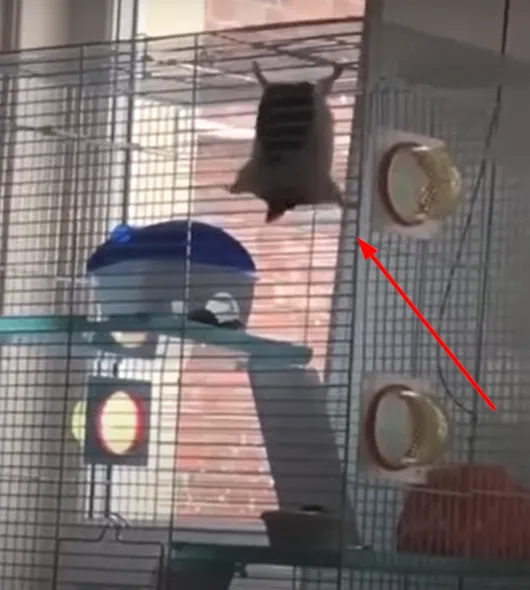
Being a responsible pet owner means being aware of your hamster’s behavior and taking proper action to help him stay safe and healthy. So, don’t ignore these signs. If you are watching a documentary about a wild animal and notice your hamster doing any of these, turn down the volume of your television as much as you can. Take him to a veterinary doctor if necessary.
How to make sure that your hamster doesn’t get scared by sudden sounds?
As a hamster parent, you can take certain measures to ensure that your hamster doesn’t get scared or stressed too often due to sudden sounds.
- Keep your hamster cage in a quiet room.
- Avoid using loud devices like a hairdryer, driller, hammer, etc., in the room your hamster is in.
- Move your hamster’s cage to another room before vacuuming.
- If it is impossible to avoid setting up the television in the same room as your hamster, turn the volume down while watching it.
- Use headphones if you want to listen to songs, audiobooks, or watch videos on your mobile phone.
- Teach children to treat your hamster properly. Instruct them to not shout or make sudden loud noises when they are in the same room as your hamster.
Can hamsters listen to music? Do hamsters like music?
Unlike mechanical sounds, music doesn’t scare your hamster. On the contrary, it is actually beneficial for his health. However, it depends on the type of music though.
Rock and pop may not be the best choice for your hamster. But classical music has been found to be good for hamsters, not just for hamsters, but all pets in general.
As prey animals that lack good eyesight, hamsters are always on high alert. They can be easily scared by a sudden sound and get stressed. But classical music can reduce their stress and anxiety by soothing their minds. This type of calm music can also help relieve pain, lower blood pressure, and aid in deep sleep (Source: Pet educate).
But having said that, the type of music a hamster likes can vary from one hamster to another. So, you can play different kinds of music and observe your hamster’s behavior to find out which type of music he likes. But regardless of the type of music you play, it shouldn’t be loud. Loud music can not only scare your hamster but also damage his hearing.
For more information, read: Do hamsters like music?
Can a loud noise make your hamster lose its hearing?
If your hamster is exposed to loud noise (>100dB) for just ten minutes, he can get Tinnitus (Ringing in the ears). If he is exposed to the same noise for more than an hour, he may even become deaf.
I know this might scare some hamster owners. But just because you own a hamster, you don’t have to live like a caveman without using any modern devices. After all, the loudness of a sound decreases with distance. As the distance to the source doubles, the sound pressure level drops by 6dB, i.e., the loudness decreases by 42%.
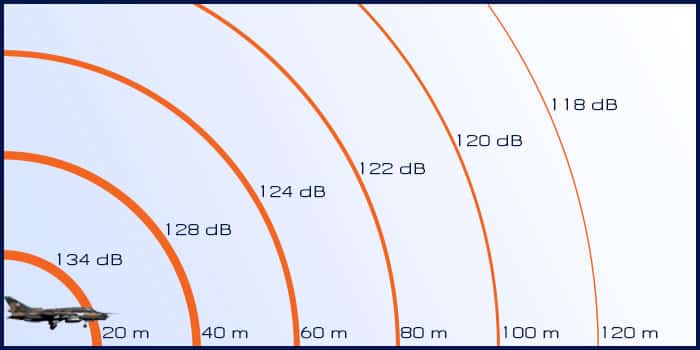
So, if you want to use a loud device, try not to do it in the same room where your hamster is in. If the usage of that device becomes unavoidable, move your hamster’s cage to another room temporarily. For example, before vacuuming a room, move your hamster’s cage to another room. After you finish vacuuming, you can bring your hamster’s cage back in.
What sounds does a hamster produce?
Just like humans, hamsters communicate with each other as well. The sounds they produce might indicate happiness, aggression, threat, or be a mating call to the opposite sex.
The wavelength of the sound an animal produces cannot be bigger than its size (Source: Britannica). So, since hamsters are tiny creatures, the sounds they make are of smaller wavelengths. And since frequency is inversely proportional to wavelength, these sounds have higher frequencies (Source: APA PsycNet). Most of these sounds lie outside the hearing range of humans. So, even if your hamster tries to communicate with you, you may not be able to hear most of these sounds. However, sometimes, you may hear it in the form of a squeak.
Do you want to find out more about hamsters? Check out our hamster guide.
Summary
There are tens of varieties of hamsters. The most famous among them are Syrian hamsters and dwarf hamsters like Chinese hamsters and Djungarian hamsters. But regardless of which hamster you buy/adopt, a hamster is a prey animal that is timid. Moreover, since his eyesight is terrible, he uses his sense of smell and hearing to find out if a predator is nearby. Hence, hamsters are sensitive to sound and can easily become frightened and stressed by sudden loud sounds.
As a hamster owner, it is your responsibility to keep your hamster safe. So, you have to make sure that the room in which your hamster lives is free of such loud sounds. To do so, you can take some of the following measures:
- Ensure that your hamster’s cage is in a quiet room.
- Use devices like a driller, hairdryer, etc., in another room.
- While vacuuming the room, move your hamster to another room so that it cannot hear the sound.
- Reduce the volume of your television.
- Use headphones while listening to music or watching videos on your cell phone.
- Don’t let children play in the room where your hamster is.
- Use soothing music to keep your hamster relaxed and calm.



